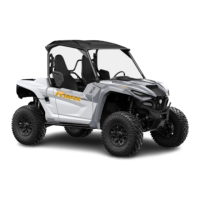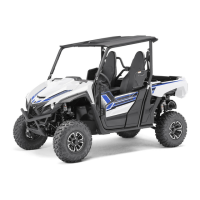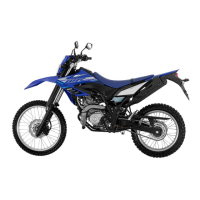Do you have a question about the Yamaha WOLVERINE RMAX4 and is the answer not in the manual?
Record key identification numbers for vehicle registration and service.
Owner's responsibility for safe operation and instructing operators/passengers.
Understand vehicle handling differences and reduce accident risk.
Overview of the vehicle's dashboard controls and instrument panel.
Explains the positions and functions of the vehicle's main ignition switch.
Details the meaning and function of various dashboard indicator and warning lights.
Describes the speedometer, odometer, clock, and other display functions.
Procedures for checking brake operation, fluid level, and leakage.
Routine checks for engine oil level and condition before operation.
Importance of checking tire pressure and recommended settings for safe operation.
Guidelines for the initial break-in period to ensure engine longevity.
Step-by-step instructions for safely starting the vehicle's engine.
How to shift gears and operate the vehicle in reverse safely.
Understanding vehicle characteristics and handling for safe operation.
Essential requirements and responsibilities for vehicle operators.
Recommended gear for drivers and passengers to minimize injury risk.
Procedures for checking, changing, and replacing engine oil and filter.
How to check and change the transmission oil level and fluid.
Comprehensive guide to brake system checks, fluid, pads, and pedal.
Location and procedure for replacing vehicle fuses to restore electrical functions.
Key engine specifications, such as combustion cycle, cooling, and valve train.
Recommended fuel type, octane rating, and tank capacity details.
Tire specifications, including size, manufacturer, and pressure recommendations.
Details of the manufacturer's warranty coverage, exclusions, and responsibilities.
Record key identification numbers for vehicle registration and service.
Owner's responsibility for safe operation and instructing operators/passengers.
Understand vehicle handling differences and reduce accident risk.
Overview of the vehicle's dashboard controls and instrument panel.
Explains the positions and functions of the vehicle's main ignition switch.
Details the meaning and function of various dashboard indicator and warning lights.
Describes the speedometer, odometer, clock, and other display functions.
Procedures for checking brake operation, fluid level, and leakage.
Routine checks for engine oil level and condition before operation.
Importance of checking tire pressure and recommended settings for safe operation.
Guidelines for the initial break-in period to ensure engine longevity.
Step-by-step instructions for safely starting the vehicle's engine.
How to shift gears and operate the vehicle in reverse safely.
Understanding vehicle characteristics and handling for safe operation.
Essential requirements and responsibilities for vehicle operators.
Recommended gear for drivers and passengers to minimize injury risk.
Procedures for checking, changing, and replacing engine oil and filter.
How to check and change the transmission oil level and fluid.
Comprehensive guide to brake system checks, fluid, pads, and pedal.
Location and procedure for replacing vehicle fuses to restore electrical functions.
Key engine specifications, such as combustion cycle, cooling, and valve train.
Recommended fuel type, octane rating, and tank capacity details.
Tire specifications, including size, manufacturer, and pressure recommendations.
Details of the manufacturer's warranty coverage, exclusions, and responsibilities.
| Engine Type | Liquid-cooled, 4-stroke, DOHC, 4-valve |
|---|---|
| Engine Displacement | 999cc |
| Starting System | Electric |
| Front Brakes | Dual hydraulic disc |
| Rear Brakes | Dual hydraulic disc |
| Drive System | On-Command 3-way locking differential; 2WD, 4WD, full diff-lock 4WD |
| Ground Clearance | 13.8 in. |
| Towing Capacity | 2, 000 lbs. |
| Fuel System | Fuel Injection |
| Front Suspension | Independent double wishbone |
| Rear Suspension | Independent double wishbone |












